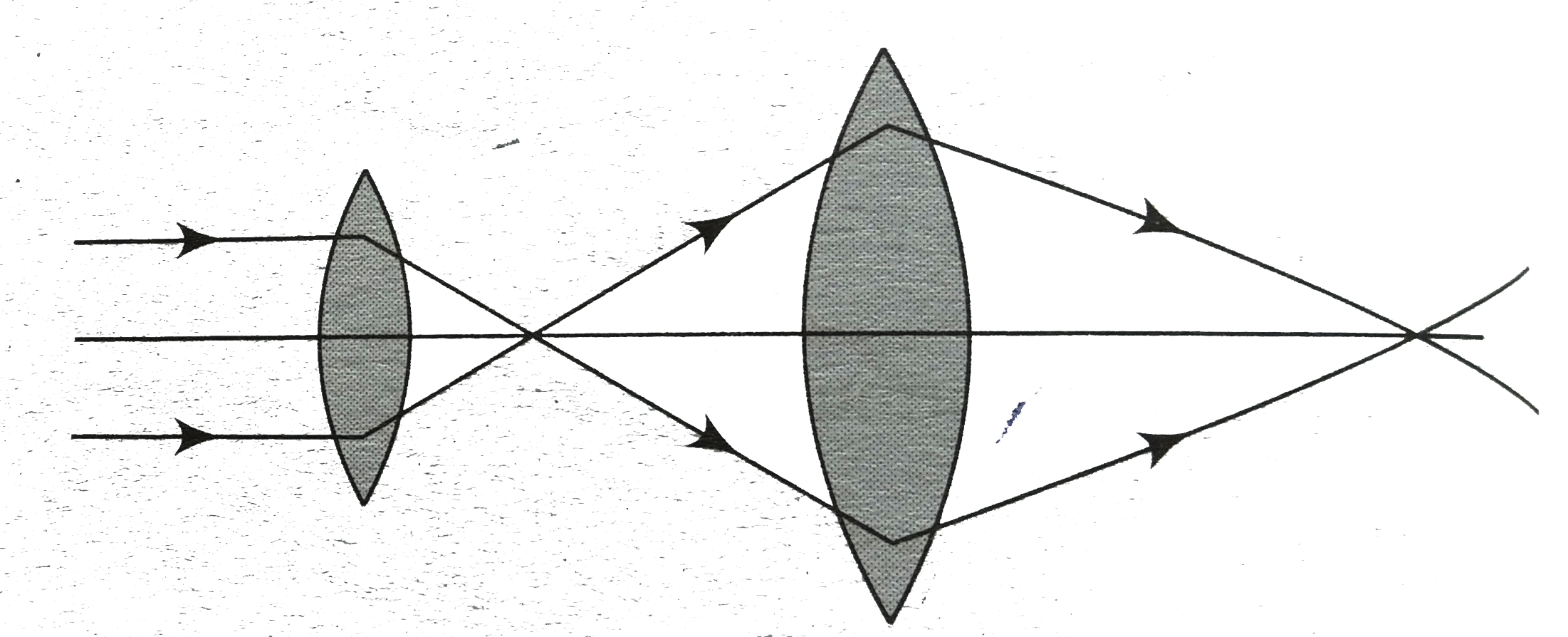Two convex lenses of focal length 20cm each are placed coaxially with a separation of 60cm between them. Find the image of a distant object formed by the combination by:
a. Using thin lense formul separately for the two lenses, and
b. Using the equivalent lens. Note that although the combination forms a real image of a distant object on the other side, it is equivalent to a diverging lens as far as the location of the final image is concerned.
a. The first image is formed at the focus of the first lens. This is at 20cm from the first lens and hence at u=−40cm from the second. Using the lens formula for the second lens,
1v=1u+1f=−140+120orv=40cm
The final image is formed 40cm to the right of the second lens.
b. The equivalent focal length is
1F=1f1+1f2−df1f2=120+120−60(20)2
or F=−20cm
It is a divergent lens. It should be kept at a distance
D=dFf1 behind the second lens.
Here, D=60×(−20)20=60cm
Thus, the equivalent divergent lens should be placed at a distance of 60cm to the right of the second lens. The final image is formed at the focus of this divergent lens, i.e., 20cm of the left of it. It is, therefore, 40 cm to the right of the second lens.

Topper's Solved these Questions
- GEOMETRICAL OPTICSBOOK - CENGAGE PHYSICSCHAPTER - GEOMETRICAL OPTICSEXERCISE - Solved Examples
15 Videos
- GEOMETRICAL OPTICSBOOK - CENGAGE PHYSICSCHAPTER - GEOMETRICAL OPTICSEXERCISE - Exercise1.1
14 Videos
- FRICTIONBOOK - CENGAGE PHYSICSCHAPTER - FRICTIONEXERCISE - QUESTION BANK
1 Video
- GRAVITATIONBOOK - CENGAGE PHYSICSCHAPTER - GRAVITATIONEXERCISE - Question Bank
39 Videos
Similar Questions
Two convex lenses f focal length 20 cm each are placed coaxially with a separation of 60 cm between them. find the image of a distance object formed by the combination by a. using thin les formula separately for the two lenses and b. using the equivalent lens. Note that although the combination forms a real image of as distance object on the other side, it is equivalent to as diverging lens as far as the locatiion of the final image is concerned.
View SolutionTwo convex lenses of focal lengths 25 cm and 15 cm are placed in contact with each other. Find the focal length of combination.
View Solution
Knowledge Check
Two thin convex lenses of focal lengths f1 and f2 are arranged coaxially with ‘d’ as the reparation between them. The equivalent lens of the combination with focal length ‘F’ to be replaced for the combination is to be placed
Amidway between the lensesBbetween the lenses positions at stance dF1f1 from position of first lensCbetween the lenses positions at distance dF1f1 from position of second lensDBetween the lenses positions at distance dF1f1+f2 from position of first lensTwo thin lenses of focal lengths 20cm and 25cm are placed in contact. The effective power of the combination is
A19 diopterB9 diopterC6 diopterD45 diopterTwo thin lenses of focal lengths 20 cm and 25 cm are placed in a contact. The effective power of the combination is
A9 DB2 DC3 DD7 D
Two convex lenses of focal length 10 cm each are combined. What will be the focal length of the combined lens ?
View SolutionTwo concave lenses, eacb of focal length 30 cm are placed in contact with each other. Find the power of the combination.
View SolutionTwo plano-convex lenses of focal lengths 20cm and 30cm are placed together to form a double convex lens. The final focal length will be
View SolutionThree lenses lenses of focal length 20 cm each are kept in contact with each other . Find the power of their combination.
View SolutionTwo thin lenses of focal lengths 20 cm and -20 cm are placed in contact with other. The combination has a focal length equal to
View Solution
